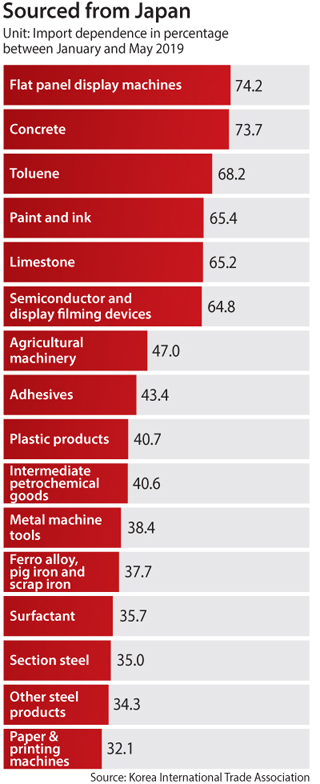Korea’s exports depend deeply on neighbor
If Japan’s economic retaliations against Korea expand beyond supplies of key materials for semiconductors and displays, the country is woefully unprepared.For while Korea is an unquestioned trade powerhouse, much of its success depends on inputs from its increasingly hostile neighbor.

Last year, Korea had a $70.5-billion trade surplus with the entire world. But with Japan, it ran a $24-billion trade deficit.
In fact, the country has never had a trade surplus with Japan since establishing trade relations in 1965.
Korea makes both end products, like smartphones and parts, and components for many things, like semiconductors and displays.
In materials and parts, Korea had a $139.1-billion trade surplus with the entire world last year.
But with Japan, it ran a $15.1-billion trade deficit in materials and parts last year.
And although its dependence on Japanese parts has declined in the past decade, it hasn’t disappeared: Japanese parts and materials account for 16.3 percent of all such imports to the country.
Japan’s retaliatory measures have so far been restricted to three key materials used to make semiconductors and displays. But according to data from the Korea International Trade Association, between January and May this year, Korea is heavily dependent on 16 products from Japan, even more than it is on semiconductor materials. These products range from materials like petrochemical goods to manufacturing machines and metal parts.
Some of those other 16 products could be restricted in the future if the trade war with Japan escalates.
Korean companies do not have an option to source those products elsewhere. Japanese companies are leaders in areas of technology and their products are highly precise and of a quality that Korean companies are unlikely to be able to replicate any time soon.
One of those 16 products is a machine that manufactures flat panel displays for mobile devices. Japan is a master of that product, analysts say, and Korea can’t catch up. To make its own display manufacturing machines, “companies need to continuously make micro-adjustments to them and make constant upgrades, but that takes time and there is no assurance that we will be making equipment with quality like Japan’s even after investing billions of won,” said Kwak Min-gi, a researcher at the Korea Electronics Technology Institute.
Korea is 74.2 percent dependent on imports of those flat panel display-making machines and 64.8 percent dependent on imports of semiconductor and display filming devices, which actually take pictures of products as they are made.
It’s a similar story for metal machine tools, 38.4 percent of which come from Japan.
“For computerized numerical control machines, more than 90 percent of which come from Japan, Korea is not that much behind Japan in terms of controlling three axes - x, y and z,” said Ji Sung-chul, a mechanical engineering professor at Dankook University. “But Japan is significantly ahead of us in terms of manufacturing speed and accuracy on controlling the rotational axis and the angular axis.”
For some steel products, Japan can’t be beat for quality or price.
“Japanese products are of better quality than those from China, and it is cheaper to ship Japanese products to Korea than from Germany,” said Sohn Il, a materials science and engineering professor at Yonsei University.
“Although the quality of some products may not be much different from those made in Korea, it can be cheaper to import them rather than making them in-house.”
Korea is also very dependent on Japan for intermediate petrochemical goods and plastic products. Although those products could be imported from other countries, local companies prefer importing from Japan for various reasons, not least of all the shorter distance.
“Domestic petrochemical companies prefer to import products from Japan as they try to diversify their supplier bases, and there are many companies that were established jointly from the Korean and Japanese capitals,” said Kim Pyung-joong, an executive of the Korea Petrochemical Industry Association.
But Japan is unlikely to include them for export restrictions, said Hong Kyung-tae, a researcher at the Korea Institute of Science and Technology, as there are plenty of other suppliers.
Korea is in a tough spot if the trade war widens as it is firmly behind Japan in the technology race. According to a report from the Ministry of Trade, Industry and Energy, while Japan has registered 68 types of promising material technologies, Korea has registered six. For parts technologies, Japan has 79 while Korea has just six of those too.
And experts say it is going to be challenging for Korean companies to find other trading partners for many parts and materials as they have based their businesses on Japanese inputs.
“For major industrial parts and materials, when assembly lines are put together, the lines are exclusively dedicated to particular items being used,” said Moon Dae-gyu, a professor of material sciences at Soonchunhyang University.
BY MOON HEE-CHUL, OH WON-SEOK AND YOUN SANG-UN [ko.juntae@joongang.co.kr]










with the Korea JoongAng Daily
To write comments, please log in to one of the accounts.
Standards Board Policy (0/250자)